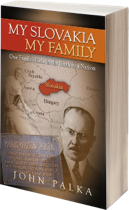Liptovský Mikuláš
October 29, 2012
Situated in one of the beauty spots of Slovakia, Liptovský Mikuláš played a major role in the Slovak National Awakening of the 19th century. It and its surrounding villages were also the home of the Pálka family for almost three centuries.
This small city lies in a broad valley nestled between the craggy High Tatra Mountains to the north and the more rounded (but nevertheless steep and wild) Low Tatras to the south. It is a great center for outdoor sports—hiking, climbing, ski mountaineering—and is home to the main training facility for Slovakia’s outstanding whitewater kayakers, who have won numerous world and Olympic medals.
A century and a half ago Mikuláš was one of the main centers of the Slovak National Awakening, the movement toward defining and uplifting Slovak language, culture, and political self-awareness. My great-granduncle Michal Miloslav Hodža led the huge Lutheran congregation in Mikuláš for thirty years while playing a leading role in this National Awakening.
From the 19th century on into the post-World War II era, the economic foundation of Mikuláš was leather production. This was a relatively minor industry at the national level, but until Czechoslovakia was established, leather was the virtually the only one in Slovak hands. Such industries as mining, smelting, and furniture making, as well as the huge agricultural estates, were owned and operated primarily by Magyars and Germans. The leathermen of Mikuláš, including my grandfather Ján Pálka and many others among my ancestors, made major contributions to the development of Slovakia as a nation by generously funding the activities of cultural and political leaders.
After a perod of decline during the past half century, Mikuláš is once again on the ascendant. Its economy is much more diversified than in the past, its cultural life is full, and the city is beautiful!

Liptovský Mikuláš is picturesquely situated in the broad valley of the River Váh, lying between the craggy High Tatra Mountains on the north and less dramatic but nevertheless imposing Low Tatra Mountains on the south. The photograph shows the Low Tatras in the background; the blue waters of Liptovská Mara, a reservoir formed by the damming of the Váh; and the buildings of Palúdzka and Ondrašová, communities that are formally independent but are functionally suburbs of greater Mikuláš.

The Catholic Church of St. Nicholas still dominates the central square of Mikuláš. Documentary evidence for the church as we see it today reaches back to the 1200s, but this Gothic structure is built on the foundations of an older Romanesque church.

The central square of Mikuláš is bordered by well preserved and colorful burgher houses and curias, the town houses of gentry and lower nobility. Today most of them have commercial spaces on the ground floor and residences above.

At one end of the square is found a sculpted water channel representing the the streams along which the leatherworks that formed the foundation of the economy of Mikuláš for several centuries were located. Set against the channel is a pair of polished panels on which the names of many of the leading personalities of Mikuláš are engraved; among them is my uncle, the composer Dušan Pálka.

The Lutheran church of Mikuláš is situated on its own small square, some distance from the main square. The statues represent two of the most important Lutherans in Slovak history: on the left Juraj Tranovský, the author of the hymnal used by Lutherans for about 300 years, on the right Michal Miloslav Hodža, my great-granduncle, who was the militant pastor of this church during the the Slovak National Awakening.


